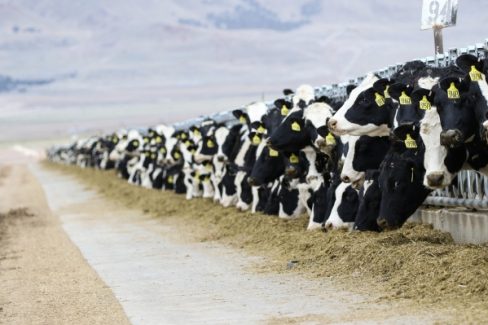Genetic selection in dairy cattle long has been used to help improve milk production and other traits that make dairy cattle more efficient, but attention to fertility hasn’t been a big part of the mix until recently.
Texas A&M AgriLife Research is leading a multi-university study aimed at helping producers determine if genetics can help improve the fertility of their herds.
“Genetics and reproduction have not been extensively explored,” said Pablo Pinedo, AgriLife Research ruminant animal health scientist in Amarillo. “We think that genetics play a role in fertility, so we are looking beyond the effect of environment, which includes proper nutrition, management, health and comfort.”
The project, “Genomic Selection for Improved Fertility of Dairy Cows with Emphasis on Cyclicity and Pregnancy,” was awarded almost $3 million over a five-year period from the U.S. Department of Agriculture within the National Institute of Food and Agriculture as a part of the 2012 Agriculture and Food Research Initiative’s Food Security program.
Halfway through the project, data from 11,000 Holstein cows on commercial dairy operations have been gathered by researchers in Texas, Ohio, Florida, New York, Wisconsin and Minnesota.
Project researchers include Jose Santos, William Thatcher, Ricardo Chebel and Klibs Galvao, all from the University of Florida; Rodrigo Bicalho and Robert Gilbert of Cornell University; Gustavo Scheunemann, The Ohio State University; Guilherme Rosa, University of Wisconsin; Sandra Rodriguez-Zas, University of Illinois; John Fetrow, University of Minnesota; and Christopher Seabury, Texas A&M University.
“We have been checking cows for fertility, measuring multiple performance variables we can see, or phenotyping,” Pinedo said. “We have been following these cows from calving to pregnancy, with two to three farms in each state and also including cows that calved both in the warm and cool seasons. Calving season has an important effect on fertility due to heat stress during the summer.
“We now have all the reproductive information, and we are building an index to rank these cows based on their fertility,” Pinedo said.
The information gathered includes reproductive diseases, resumption of ovarian cyclicity, body condition, lameness, metabolic diseases, time to pregnancy and pregnancy loss, he said.
“The top cow will be the one that never got sick and got pregnant in a timely manner,” Pinedo said.
The next step is to take the indexing information from this group of 11,000 cows and narrow the numbers to the top 1,000 cows and the bottom 1,600 cows, he said. This selected group will go through a DNA analysis, utilizing the highest density genotyping chip available.
Then the bioinformatics group on the team will analyze the genetic information and try to find significant associations between genetic variations and fertility, Pinedo said.
He added that so far, a large variation in both disease presentation and fertility across farms and regions has been found, providing excellent data for this study.
While fertility is the ultimate goal of this study, Pinedo said, the data that was gathered by goingng onto these farms every week can be used to determine which points or markers are indicators of good health.
Source – theeagle.com




